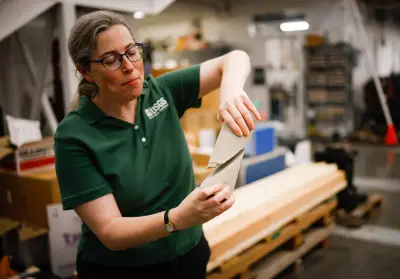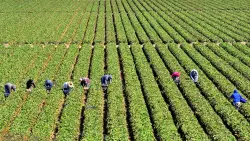The next big earthquake: When is the Bay Area due?

California has dozens of earthquakes every day The majority are below magnitude so small that they aren t felt But a scant like the San Francisco earthquake are massive capable of widespread destruction The last vital damaging earthquake in the Bay Area was the South Napa Quake on Aug which killed person injured and caused billion in damage in Napa and Vallejo Before that it was the magnitude Loma Prieta Earthquake on Oct which disrupted the World Series and wrecked the Bay Bridge Oakland s Cypress Freeway downtown Santa Cruz and parts of San Francisco killing people Related Articles Who is watching for earthquakes volcanoes and tsunamis Trump is cutting the guardians at the gate Watch During Monday s quake elephants form alert circle at San Diego Safari Park Magnitude earthquake jolts Southern California Magnitude earthquake rattles Hollister area Magnitude earthquake jolts East Bay The Bay Area has had a quiet sparse decades Is it due for another major quake any time soon Sarah Minson is a research geophysicist with the U S Geological Survey s Earthquake Science Center at Moffett Field This conversation has been condensed and edited for clarity and length Q What s the current peril of a major quake occurring in the Bay Area A There is about a probability of one or more magnitude or larger earthquakes within years in the San Francisco Bay Area Q That sounds pretty high How aware of that jeopardy do you think Bay Area residents are A Relative to other parts of the country or possibly even other parts of California people in the Bay Area do tend to be very well aware because of events like Loma Prieta and the Napa earthquake They happened in living memory And even if there is consistently a new group of arrivals in the Bay Area or young kids who haven t lived through them it is within a human lifespan so there is a lot more lived experience stories from your close friends and family than in other places where earthquakes happen only once every years or years Q What would the impact be of a to a quake in the Bay Area in the present day A I like the fact that you re asking about -to- magnitude earthquakes because it turns out that largest part of our earthquake menace is from magnitude -ish earthquakes rather than a magnitude big one like the earthquake That s just because they happen so much more often A good rule of thumb is that every magnitude decrease is an increase by a factor of in how frequently earthquakes happen So for every magnitude like the San Francisco earthquake there are Loma Prieta-sized earthquakes and Napa-sized earthquakes and magnitude earthquakes Even though each of those smaller earthquakes impacts a smaller area and they are less likely to cause damage they happen so much more frequently that overall the danger from them is higher Q Why is that A A colleague of mine likes to say that the comparison between big and small earthquakes is like the difference between sharks and cows Think of big earthquakes like sharks and little earthquakes like cows Sharks are scary Cows are not But you almost never come face to snout with a shark right Whereas you meet cows all the time And if you look at the statistics it turns out that sharks kill on average about five people a year and cows kill on average about people a year So even though the Napa earthquake didn t impact all of Northern California like the San Francisco earthquake did the shaking locally in Napa was seemingly higher there than it was during the earthquake These earthquakes that we experience year after year and decade after decade are in fact where majority of of our hazard comes from When you re thinking about preparing for an earthquake these are really the kinds of earthquakes you want to be preparing for The cataclysmic earthquakes happen so infrequently They are the sharks But the cows are what s going to get you Q Which faults in the Bay Area are of most of concern A In general the Hayward Fault seems to have the highest rate of earthquakes Not in our lifetime But if you look in the s there were a number of earthquakes and so overall that seems to be the highest rate long term followed by the San Andreas Fault Q The Hayward Fault seems to be the one we hear people the bulk worried about Is that fair A Everyone is concerned about the faults to go through the urban core But it s significant to know that your hazard isn t necessarily governed by your proximity to the fault It s not the earthquake itself that causes damage It s the shaking from the earthquake or potentially liquefaction or landslides In fact one of the highest hazard places in the Bay Area would be the Santa Clara Valley because it s right in between the Hayward Fault and the San Andreas Fault so it s going to feel shaking if there s an earthquake on either of them On top of that it s a valley full of soft sediment and soft sediment can amplify shaking Q What should you do if you feel an earthquake A You have bookcases in buildings that can tip over or books that can just fall out of a bookcase You might have a chandelier over your head That s why if you feel shaking you should drop cover and hold on to protect yourself Don t go anywhere Don t run outside A huge number of the injuries that occur in earthquakes are people stepping on broken glass or trying to run during the shaking and falling down Q How should we prepare A The sort of things you need to do are the things you need in any other calamity like large winter storms and wildfires You want to have a plan to be in contact with your family in matter normal communication or transportation is interrupted You want water food those sorts of things Think of your pets You can go to ready gov for more information Q What s the takeaway message A Earthquakes are something that you don t want to be fatalistic about We have a tendency to focus on apocalyptic stories of magnitude earthquakes on the San Andreas Fault or magnitude on the Cascadia Subduction Zone that bring destruction to a huge swath of the state If you re an exigency manager or someone like that you should be prepared for these possibilities But for you as a human with a human life span the thing much more likely to impact you is not even something like Loma Prieta but something like the Napa earthquake These earthquakes are very survivable They don t even necessarily have to interrupt your life all that much with specific very simple preparedness Five stimulating things about Sarah Minson Raised in Mendocino County California Earned her bachelor s degree in geophysics at UC Berkeley in Earned her master s and doctorate degrees in geophysics at the California Institute of Device in and with a doctoral thesis on A Bayesian Approach to Earthquake Source Studies Expert in rupture models earthquake early warning systems earthquake source mechanisms crustal deformation and population outreach of seismic issues Awards include USGS Superior Amenity Award Kavli Fellow National Academy of Sciences and The Kavli Foundation U S Geological Survey STAR Award Presidential Early Career Award for Scientists and Engineers

